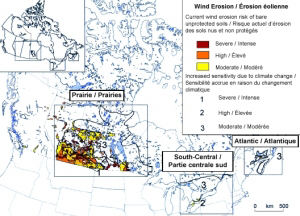| Climate Change Impacts and Adaptation |
| Sensitivities to Climate Change in Canada |
Proactive disclosure
Print version   |  | 
Natural Resources Canada > Earth Sciences Sector > Priorities > Climate Change Impacts and Adaptation > Sensitivities to Climate Change in Canada
Sensitivities to Climate Change in Canada Wind erosion
Wind erosion affects agricultural lands and sandy soils in many parts of Canada, causing soil and nutrient losses, reduced crop yields, sand dunes and dust storms. A relatively good understanding exists of wind erosion under present-day conditions. Currently, the highest wind erosion risk to bare, unprotected soils (coloured areas in the figure) occurs on the southern prairies, with moderate risks also occurring in British Columbia, southern Ontario and the Maritimes.

Map 6
|
The impacts of predicted climate change in Canada with respect to wind erosion are associated with changes in moisture conditions, brought about by changes in the timing and amount of precipitation and changes in temperature. Those areas experiencing an increased sensitivity to wind erosion (see numbered areas on Map 6) are also likely to experience more severe droughts. The southern Prairies have the greatest sensitivity, with high sensitivity in the central Prairies and the southernmost regions of Ontario and moderate sensitivity in northern Saskatchewan and Manitoba, in southern Ontario and Quebec and in portions of the Maritimes.
Contact: Steve Wolfe
|
